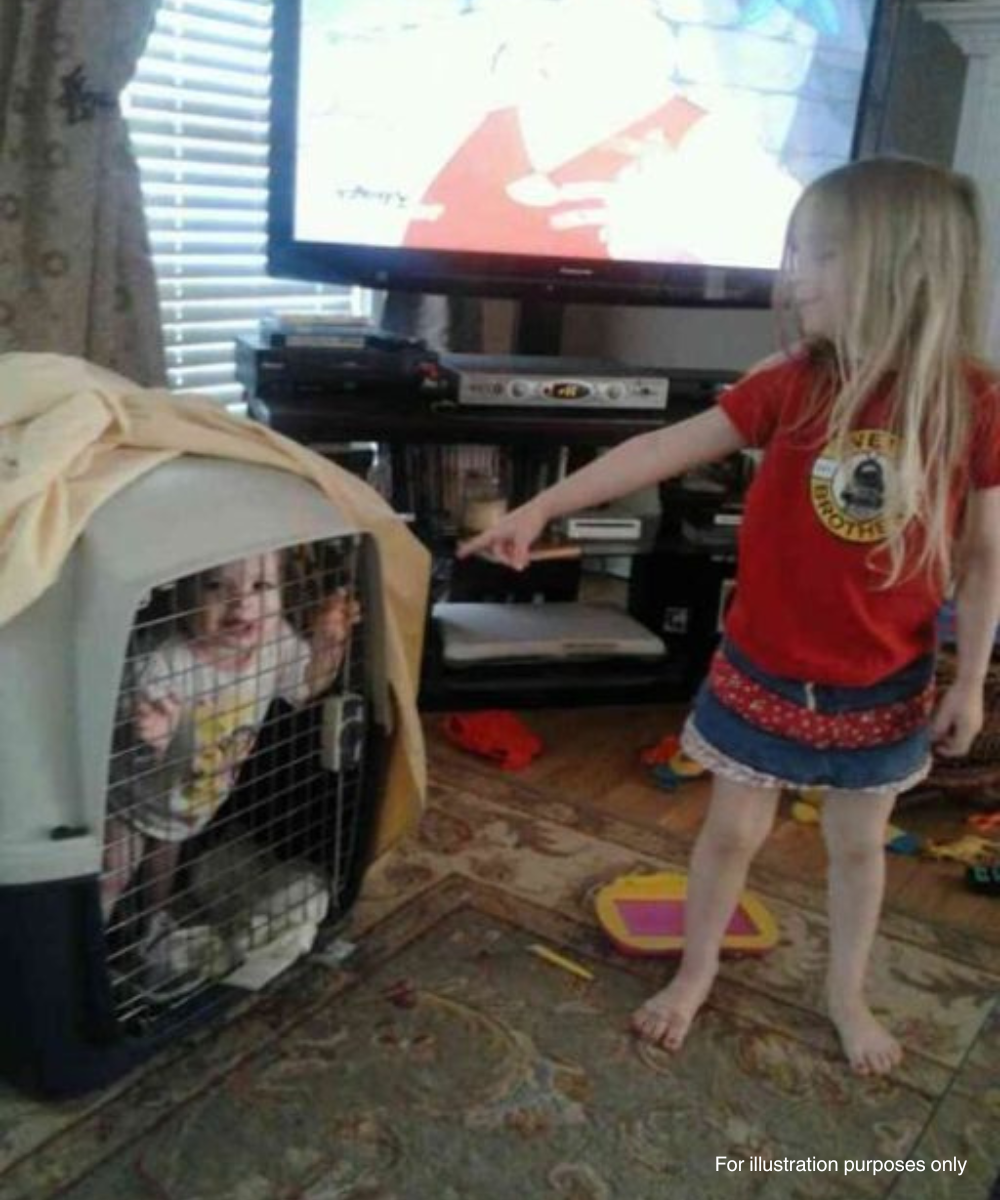I was gone for two hours. Just two.
A quick grocery run and a stop to pick up a gift for my sister. The babysitter—Kelsie—came highly recommended. Early childhood education major, CPR certified, calm and responsible. Checked all the boxes.
But when I stepped through the front door…
Something felt wrong.
No laughter. No running footsteps.
Just the flicker of cartoons on the TV and the unsettling silence of a home that should be filled with noise.
Then—I saw it.
In the middle of the living room sat our dog crate. The kind we use for Bruno, our retriever. But it wasn’t Bruno inside.
It was my daughter. Ellie.
Four years old, sitting criss-cross in that crate.
Her cheeks were red. Her eyes puffy.
And her twin brother, Max, stood beside her—barefoot and pointing like this was part of some twisted joke.
I froze.
“What the hell is going on?” I asked, my voice already trembling.
Kelsie looked up from her phone in the kitchen. Calm. Unbothered.
“Oh,” she said casually, “they were playing zoo. She wanted to be the tiger.”
But Ellie’s voice—small, cracked—cut through that lie.
“She locked it, Mommy. I told her I didn’t wanna play anymore.”
I looked down.
The crate was latched shut.
I turned to Kelsie, my heartbeat pounding in my ears.
“You locked a four-year-old in a crate?”
“She was being dramatic,” she shrugged. “I didn’t want to encourage that behavior.”
That behavior?
The blood drained from my face.

I crouched and opened the latch. Ellie leapt into my arms, gripping my neck like she was afraid I’d disappear. Max looked confused—unsure if he’d done something wrong or if this was just another “game.”
Meanwhile, Kelsie still leaned on the counter, scrolling her phone like none of it mattered.
“You’re done here,” I said, voice low but sharp.
“Get your things. And don’t come back.”
She rolled her eyes, muttered something about parents being “too soft.” I didn’t respond. I waited until the door slammed behind her.
Then, I sat on the couch with my kids in my arms, heartbroken. Silent.
That night, after the twins fell asleep, I took the photo I’d snapped of Ellie’s tear-streaked face in front of that crate and emailed it—with a full report—to the agency that referred Kelsie.
They were horrified. Promised she’d be permanently removed from their roster.
But something still didn’t sit right.
The next morning, I called Ellie’s preschool teacher.
“Has Ellie ever said anything… odd?” I asked. “Anything about games or being scared?”
There was a pause.
Then the teacher said quietly, “She drew a picture last week. Of a cage. We asked her about it. She said it was a game the babysitter played.”
I nearly dropped the phone.
How long had this been going on?
I remembered the times I’d come home and found Ellie quiet, Max overly excited. The strange tension I’d chalked up to post-nap crankiness. The drawings I hadn’t asked enough about.
I sat down with Max the next day, just the two of us, coloring.
“Hey buddy… that zoo game you played. Have you done that before?”
“Yeah,” he said easily. “Ellie always the tiger.”
“Always?”
He nodded.
“She don’t like it. But Kelsie says girls have to take turns being quiet.”
Girls have to take turns being quiet.
I wanted to scream. But guilt screamed louder.
I had let this happen. More than once. To my own children.
But guilt doesn’t change anything. Action does.
So I told the story. Quietly, at first—other moms at preschool. I showed them the photo. Two had used Kelsie before. One said her toddler refused to play pretend for weeks after being babysat by her.
It spread.
A local parenting board reached out. They were building a new vetting system for child care providers. They asked if I’d be willing to speak.
I said yes.
It wasn’t easy. But every time I told the story, someone else came forward. A mom whose child started hiding during nap time. Another who found her son locked in the pantry during “quiet time.” Kelsie had been fired from a daycare before—for “boundary issues.” But it was buried in NDAs and soft language.
No one had connected the dots. Until now.
And something else happened too.
Ellie started drawing again—but this time, no cages. Just rainbows. Animals. Smiling people.
Max began smiling more, laughing louder.
And me? I forgave myself. Slowly.
Because I did believe Ellie when it mattered.
I took her seriously. I protected her.
And I spoke up—so others could, too.
Three months later, the agency called. They’d overhauled their entire screening system—added surprise visits, mandatory interviews, peer references.
It was no longer about one sitter.
It was about changing a system that failed to listen to children.
Then, one day on the sidewalk, pushing the twins home from preschool, a young woman stopped me.
“Are you the mom who spoke at the board meeting?”
I nodded.
“I just wanted to thank you,” she said. “I’m a sitter too—and because of what you said, parents are asking more questions now. The right questions.”
Her name was Maira. Her references included a retired pediatric nurse. I met with her. Hired her.
She still watches Ellie and Max today.
Ellie still doesn’t like cages—not even in cartoons. And Max still brings up the zoo game now and then. But the biggest change?
Ellie speaks up now.
She tells me when something feels wrong. She tattles on Max for sneaking cookies. She’s loud. She’s brave.
And I listen.
Because kids may be small—but their voices matter.
So if you’re reading this, hug your kids tonight. Ask about their drawings. Ask about the “games.” And if something feels off… don’t ignore it.
Trust your gut.
Believe them the first time.
Because no child should ever feel like a tiger in a cage.